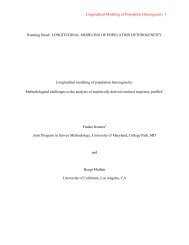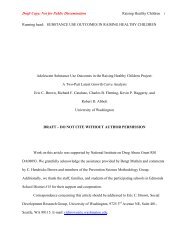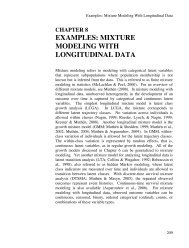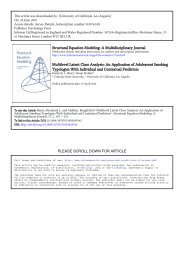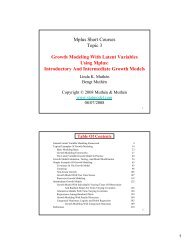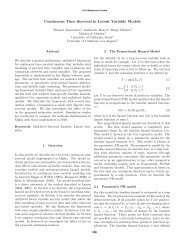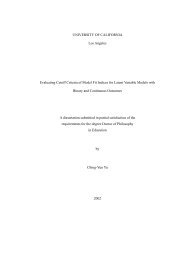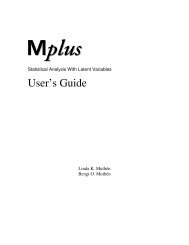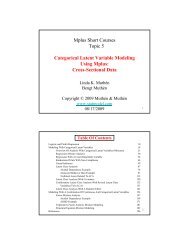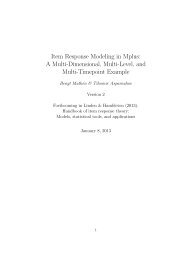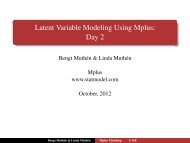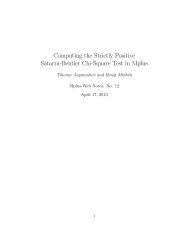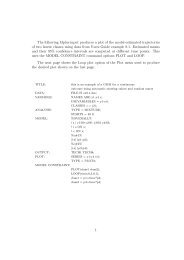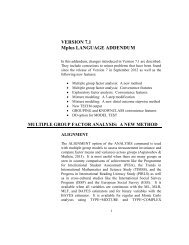How To Use A Monte Carlo Study To Decide On Sample ... - Mplus
How To Use A Monte Carlo Study To Decide On Sample ... - Mplus
How To Use A Monte Carlo Study To Decide On Sample ... - Mplus
Create successful ePaper yourself
Turn your PDF publications into a flip-book with our unique Google optimized e-Paper software.
<strong>How</strong> <strong>To</strong> <strong>Use</strong> A <strong>Monte</strong> <strong>Carlo</strong> <strong>Study</strong> <strong>To</strong> <strong>Decide</strong> <strong>On</strong> <strong>Sample</strong> Size and Determine Power<br />
Linda K. Muthén<br />
Muthén & Muthén<br />
11965 Venice Blvd., Suite 407<br />
Los Angeles, CA 90066<br />
Telephone: (310) 391-9971<br />
Fax: (310) 391-8971<br />
muthen@statmodel.com<br />
Bengt Muthén<br />
University of California, Los Angeles<br />
Graduate School of Education & Information Studies<br />
2023 Moore Hall, Mailbox 951521<br />
Los Angeles, CA 90095-1521<br />
Telephone: (310) 206-1226<br />
Fax: (310) 206-6293<br />
bmuthen@ucla.edu<br />
Running head: SAMPLE SIZE AND POWER<br />
April 9, 2002
ABSTRACT<br />
A common question asked by researchers is, “What sample size do I need for my study?”<br />
Over the years, several rules of thumb have been proposed. In reality there is no rule of<br />
thumb that applies to all situations. The sample size needed for a study depends on many<br />
factors including the size of the model, distribution of the variables, amount of missing<br />
data, reliability of the variables, and strength of the relationships among the variables.<br />
The purpose of this paper is to demonstrate how substantive researchers can use a <strong>Monte</strong><br />
<strong>Carlo</strong> study to decide on sample size and determine power. Two models are used as<br />
examples, a confirmatory factor analysis (CFA) model and a growth model. The<br />
analyses are carried out using the <strong>Mplus</strong> program (Muthén & Muthén, 1998).<br />
2
A common question asked by researchers is, “What sample size do I need for my study?”<br />
Over the years, several rules of thumb have been proposed such as 5-10 observations per<br />
parameter, 50 observations per variable, no less than 100, and so on. In reality there is no<br />
rule of thumb that applies to all situations. The sample size needed for a study depends<br />
on many factors including the size of the model, distribution of the variables, amount of<br />
missing data, reliability of the variables, and strength of the relationships among the<br />
variables. Although parameter estimates frequently have small bias, standard errors are<br />
more sensitive. Standard errors may be overestimated or underestimated depending on<br />
the situation. This affects the estimation of confidence intervals also referred to as<br />
coverage. If standard errors are overestimated, significant effects may be missed. If they<br />
are underestimated, significant effects may be overstated. Another issue that needs to be<br />
considered when deciding on sample size is power. A sample may be large enough for<br />
unbiased parameter estimates, unbiased standard errors, and good coverage, but it may<br />
not be large enough to detect an important effect in the model.<br />
The purpose of this paper is to demonstrate how substantive researchers can use a <strong>Monte</strong><br />
<strong>Carlo</strong> study to decide on sample size and determine power. Two models are used as<br />
examples, a confirmatory factor analysis (CFA) model and a growth model. The<br />
analyses are carried out using the <strong>Mplus</strong> program (Muthén & Muthén, 1998) which has<br />
extensive <strong>Monte</strong> <strong>Carlo</strong> facilities. Data generation using <strong>Mplus</strong> can include normal data,<br />
non-normal data, missing data, clustering, and mixtures of populations. Analysis models<br />
can include any of the models available in <strong>Mplus</strong>. Data generation and analysis models<br />
do not need to be the same.<br />
This paper focuses on parameter estimates, standard errors, coverage, and power<br />
assuming correctly specified models. Mis-specified models can also be studied in the<br />
<strong>Mplus</strong> <strong>Monte</strong> <strong>Carlo</strong> framework, but are not included here. Also, it should be noted that<br />
<strong>Monte</strong> <strong>Carlo</strong> studies are useful for evaluating the performance of model fit indices, but<br />
this use is not considered in the paper.<br />
METHOD<br />
A common use of <strong>Monte</strong> <strong>Carlo</strong> studies is for methodological investigations of the<br />
performance of statistical estimators under various conditions. In these studies, data are<br />
generated and models are estimated, sometimes using more than one estimator. The<br />
performance of an estimator is judged by studying parameter estimate bias, standard error<br />
bias, and coverage. A less common use of <strong>Monte</strong> <strong>Carlo</strong> studies is to decide on sample<br />
size and determine power in the design of substantive studies. This use is the focus of the<br />
paper.<br />
MONTE CARLO STUDY<br />
In <strong>Monte</strong> <strong>Carlo</strong> studies, data are generated from a population with hypothesized<br />
parameter values. A large number of samples are drawn, and a model is estimated for<br />
each sample. Parameter values and standard errors are averaged over the samples. The<br />
3
following criteria are examined: parameter estimate bias, standard error bias, and<br />
coverage.<br />
Several decisions need to be made to carry out a <strong>Monte</strong> <strong>Carlo</strong> study. The first is the<br />
choice of the model to be studied. This choice is driven by the research question being<br />
asked. <strong>On</strong>ce the model is chosen, population values for each parameter of the model<br />
must be selected. These values can be obtained from theory or previous research.<br />
Estimates from previous studies are often the best estimates available for population<br />
values in the <strong>Monte</strong> <strong>Carlo</strong> study.<br />
Technical considerations in the <strong>Monte</strong> <strong>Carlo</strong> study are the number of samples to be drawn<br />
and the seed. The number of samples to be drawn (replications) can be thought of as the<br />
sample size for the <strong>Monte</strong> <strong>Carlo</strong> study. The number of replications should be increased<br />
until stability of the results is achieved. In this study, 10,000 replications are used for<br />
each analysis to insure that stability has been reached. The value of the seed determines<br />
the starting point for the random draws of the samples. More than one seed should be<br />
used, and the results for the different seeds should be checked for stability.<br />
MODELS TO BE STUDIED<br />
A CFA model and a growth model were selected for study. These models were chosen<br />
because they are often used in practice and are sufficiently different from each other.<br />
CFA models are typically cross-sectional and have only a covariance structure. The<br />
growth model is longitudinal and has both a mean and covariance structure.<br />
Confirmatory Factor Analysis Model<br />
The CFA model that is studied has two factors, each of which has five continuous factor<br />
indicators. The CFA model has 31 free parameters and 24 degrees of freedom. A<br />
diagram of the CFA model is shown in Figure 1. Data are generated using the following<br />
population values. The factor loadings are 0.8. The residual variances of the factor<br />
indicators are 0.36. Factor variances are fixed to one to set the metric of the factors. The<br />
Insert Figure 1 Here<br />
factor correlation is 0.25. All factor loadings are free. These population values are<br />
chosen so that the variances of the factor indicators are one which makes the parameter<br />
values more easily interpretable. The population values result in a reliability of 0.64 for<br />
each factor indicator. Reliability is calculated as the ratio of the variance of the factor<br />
indicator explained by the factor to the total variance of the factor indicator using the<br />
following formula,<br />
(1) λ 2 ψ / (λ 2 ψ + θ) ,<br />
where λ is the factor loading, ψ is the factor variance, and θ is the residual variance.<br />
4
The focus of the power investigation in the CFA model is the factor correlation. This<br />
parameter is of particular interest because it represents the correlation between the two<br />
constructs unattenuated by measurement error. The CFA model can also be thought of<br />
as a longitudinal model with two measurement occasions so that the last five indicators<br />
are repeated measures of the first five indicators. In this case, the factor correlation can<br />
be seen as a measure of stability of the construct over time.<br />
The CFA model is examined under four conditions: (1) normally distributed continuous<br />
factor indicators without missing data, (2) normally distributed continuous factor<br />
indicators with missing data, (3) non-normal continuous factor indicators without missing<br />
data, and (4) non-normal continuous factor indicators with missing data.<br />
Missing Data<br />
In the analyses with missing data, the data are generated such that all subjects have data<br />
on y1, y2, y3, y4, and y5 and 50 percent of the subjects have data on y6, y7, y8, y9, and<br />
y10. The patterns of missing data should be specified to reflect missing data patterns<br />
seen in practice. For example, the percent of missing data can increase in relation to the<br />
number of questions in a survey to reflect the likelihood that subjects become tired<br />
toward the end of a survey and start skipping questions. Or the percent of missing data<br />
can increase over time reflecting the likelihood that people will drop out of a study. If a<br />
study is designed such that some subjects receive only a subset of the items on a survey<br />
or are measured only at certain ages, this can also be reflected in the generation of data.<br />
The way missing data are generated for the CFA model is an example of missing<br />
completely at random (MCAR; Little & Rubin, 1987).<br />
Non-Normal Data<br />
In the analyses with non-normal data, the data are created using a mixture of two normal<br />
subpopulations or classes of individuals. Normal data are generated for two classes that<br />
have different means and variances for the factor indicators. The combined data are<br />
analyzed as though they come from a single population. <strong>To</strong> maintain a similarity<br />
between the CFA models without and with missing data, the parameter values for the<br />
factor indicators are chosen so that their reliabilities are 0.64 using equation (1).<br />
The first step is to generate data for two classes such that the combination of the data<br />
from the two classes has the desired skewness and kurtosis. This is done by allowing one<br />
of the classes to represent an outlying group of individuals that has different means and<br />
variances for the factor indicators. The choice of the proportion of individuals in the two<br />
classes also affects skewness and kurtosis. <strong>To</strong> insure that the model for the combined<br />
data is a correctly specified CFA model, skewness and kurtosis in the factor indicators is<br />
achieved by choosing different means and variances for the factors, not by manipulating<br />
the means and variances of the factor indicators.<br />
For the CFA model with non-normal data, Class 1, the outlier class, contains 12 percent<br />
of the subjects and Class 2 contains the remaining 88 percent. <strong>On</strong>ly the factor indicators<br />
5
for the second factor are non-normal. Therefore, the Class 1 mean for the second factor<br />
is chosen to be 15 and the variance 5 as compared to the Class 2 mean and variance of<br />
zero and one. The resulting population univariate skewness for variables y6 through y10<br />
is 1.2. The resulting population univariate kurtosis for variables y6 through y10 ranges<br />
from 1.5 to 1.6.<br />
The second step is to run the analysis with one replication and a large sample to obtain<br />
approximate population values for the one class model. In this paper, a sample size of<br />
100,000 is used. Given that factor indicator reliabilities of 0.64 are desired, the third step<br />
is to solve for the population residual variances for the factor indicators of the second<br />
factor using equation (1) and use those values as the population values for data<br />
generation.<br />
Growth Model<br />
Two growth models are studied. Both are linear growth models with equidistant time<br />
points for four continuous outcomes. <strong>On</strong>e has a covariate influencing the intercept and<br />
slope growth factors. The growth model without a covariate has 9 free parameters and 5<br />
degrees of freedom. The growth model with a covariate has 11 free parameters and 7<br />
degrees of freedom. Figure 2 shows the diagram for the growth model with the covariate.<br />
Data are generated using the following population values. For the growth model without<br />
a covariate, the mean of the intercept growth factor is 0.0 and the mean of the slope<br />
growth factor is 0.2. The variance of the intercept growth factor is 0.5 and the variance<br />
Insert Figure 2 Here<br />
of the slope growth factor is 0.1, reflecting a commonly seen variance ratio. The<br />
covariance between the intercept and slope growth factors is zero. The residual<br />
variances of the continuous outcomes are 0.5. This results in R-square values of 0.50 for<br />
y1, 0.55 for y2, 0.64 for y3, and 0.74 for y4 using the following formula,<br />
(2) R-square (yt) = (ψi + xt 2 ψs+ 2 xt ψis)/(ψi + xt 2 ψs + 2 xt ψis + θt),<br />
where ψi is the variance of the intercept growth factor, xt is the time score at time t, ψs is<br />
the variance of the slope growth factor, ψis is the covariance between intercept and slope<br />
growth factors (set at zero in this case), and θt is the residual variance for the outcome at<br />
time t. Here the xt time scores are chosen as 0, 1, 2, and 3.<br />
In the growth model with a covariate, the intercept and slope growth factors are regressed<br />
on a dichotomous covariate with a 50/50 split giving the covariate a mean of 0.5 and a<br />
variance of 0.25. This covariate can be thought of as a treatment or gender dummy<br />
variable. For the intercept growth factor, the regression coefficient is 0.5. The residual<br />
variance for the intercept growth factor is chosen as 0.25. This corresponds to an Rsquare<br />
value of 0.20 for the intercept growth factor.<br />
6
The focus of the power investigation in the growth model is the regression coefficient in<br />
the regression of the slope growth factor on the covariate. This parameter is selected<br />
because across-group differences in development over time are the focus of many<br />
longitudinal studies. Regression coefficient values of 0.2 and 0.1 are chosen to study<br />
different effect sizes. A regression coefficient of 0.2 has an effect size of 0.63 reflecting<br />
a medium effect (Cohen, 1969). A slope of 0.1 has an effect size of 0.32 reflecting a<br />
small effect. Here effect size is computed as the ratio of the difference in the slope<br />
means for the two values of the covariate divided by the standard deviation of the slope<br />
growth factor. The residual variance for the slope growth factor is chosen as 0.09. This<br />
corresponds to an R-square value of 0.10 for the slope growth factor when the regression<br />
coefficient is 0.2 and an R-square of 0.03 when the regression coefficient is 0.1. Values<br />
as low as these are commonly seen in the prediction of the slope growth factor.<br />
The growth model is examined under five conditions: (1) normally distributed continuous<br />
outcomes without missing data without a covariate, (2) normally distributed continuous<br />
outcomes without missing data with a covariate that has a regression coefficient of 0.2 for<br />
the slope growth factor, (3) normally distributed continuous outcomes with missing data<br />
with a covariate that has a regression coefficient of 0.2 for the slope growth factor, (4)<br />
normally distributed continuous outcomes without missing data with a covariate that has<br />
a regression coefficient of 0.1 for the slope growth factor, and (5) normally distributed<br />
continuous outcomes with missing data with a covariate that has a regression coefficient<br />
of 0.1 for the slope growth factor.<br />
Missing Data<br />
In the analyses with missing data, the data are generated to reflect an increase in missing<br />
data over time due to attrition. For the second through the fourth time points, the<br />
probability of missing data is influenced by the covariate, while the first time point has<br />
data missing completely at random (MCAR). For the covariate value of zero, the first<br />
measurement occasion has 12 percent missing on the outcome, the second has 18 percent<br />
missing, the third has 27 percent missing, and the fourth has 50 percent missing. For the<br />
covariate value of one, the first measurement occasion has 12 percent missing on the<br />
outcome, the second has 38 percent missing, the third has 50 percent missing, and the<br />
fourth has 73 percent missing. The way missing data are generated for the growth model<br />
is an example of missing at random (MAR; Little & Rubin, 1987).<br />
MODEL ESTIMATION<br />
Model estimation is carried out in all cases by maximum likelihood under the assumption<br />
of normality. For models with non-normal data, standard errors are computed using a<br />
non-normality robust sandwich estimator. All analyses are done using the <strong>Mplus</strong><br />
program. All <strong>Mplus</strong> inputs used for the paper are included in Appendix 1 and are<br />
available at www.statmodel.com. Complete outputs are also available at this website.<br />
7
STRATEGY FOR DECIDING ON SAMPLE SIZE<br />
Several criteria are examined to determine sample size. The first criterion is that<br />
parameter and standard error biases do not exceed 10 percent for any parameter in the<br />
model. The second criterion is that the standard error bias for the parameter for which<br />
power is being assessed does not exceed 5 percent. The third criterion is that coverage<br />
remains between 0.91 and 0.98. <strong>On</strong>ce these three conditions are satisfied, the sample size<br />
is chosen to keep power close to 0.80. The value of 0.80 is used because it is a<br />
commonly accepted value for sufficient power.<br />
Appendix 2 shows partial output from the <strong>Mplus</strong> analysis for the CFA model with<br />
normally distributed continuous factor indicators without missing data. All outputs from<br />
the analyses in this paper are available at the website www.statmodel.com. Following is<br />
a description of how the information in the output is used to evaluate the criteria<br />
discussed above.<br />
Parameter bias is evaluated using the information in columns one and two of the output.<br />
The column labeled Starting gives the population parameter values. The column labeled<br />
Average gives the parameter estimate average over the replications of the <strong>Monte</strong> <strong>Carlo</strong><br />
study. For example, the first number in column 2, 0.7963, is the average of the factor<br />
loading estimates for y1 over 10,000 replications. <strong>To</strong> determine its bias, subtract the<br />
population value of 0.8 from this number and divide it by the population value of 0.8.<br />
This results in a bias of -0.005 which is negligible.<br />
Standard error bias is evaluated using the information in columns three and four of the<br />
output. The column labeled Std. Dev. gives the standard deviation of each parameter<br />
estimate over the replications of the <strong>Monte</strong> <strong>Carlo</strong> study. This is considered to be the<br />
population standard error when the number of replications is large. The column labeled<br />
S.E. Average gives the average of the estimated standard errors for each parameter<br />
estimate over the replications of the <strong>Monte</strong> <strong>Carlo</strong> study. Standard error bias is calculated<br />
in the same way as parameter estimate bias as described above.<br />
Coverage is evaluated using the information in column 6 of the output labeled 95%<br />
Cover. It gives the proportion of replications for which the 95% confidence interval<br />
contains the true parameter value.<br />
Power is evaluated using the information in column 7 of the output labeled % Sig Coeff.<br />
This column gives the proportion of replications for which the null hypothesis that a<br />
parameter is equal to zero is rejected for each parameter at the .05 level (two-tailed test<br />
with a critical value of 1.96). The statistical test is the ratio of the parameter estimate to<br />
its standard error, an approximately normally distributed quantity (z-score) in large<br />
samples. For parameters with population values different from zero, this value is an<br />
estimate of power, that is, the probability of rejecting the null hypothesis when it is false.<br />
For parameters with population values equal to zero, this value is an estimate of Type I<br />
error, that is, the probability of rejecting the null hypothesis when it is true.<br />
8
FINDINGS<br />
CONFIRMATORY FACTOR ANALYSIS MODEL<br />
The results of the four CFA analyses are found in Table 1. For the simplest CFA model<br />
with normally distributed continuous factor indicators and no missing data, a sample size<br />
of 150 is needed for power of 0.81 to reject the hypothesis that the factor correlation is<br />
zero. By adding the complication of missing data, a sample size of 175 is required for<br />
power of 0.81. Considering the CFA model with non-normal factor indicators<br />
without missing data, a sample size of 265 is needed for a power of 0.80. Adding the<br />
complication of missing data results in the need for a sample size of 315 for power of<br />
0.81.<br />
GROWTH MODEL<br />
Insert Table 1 Here<br />
The results of the five growth model analyses are found in Table 2. For the simplest<br />
growth model without missing data and without a covariate, a sample size of 40 is needed<br />
for power of 0.81 to reject the hypothesis that the mean of the slope growth factor is zero.<br />
By adding a dichotomous covariate with population regression coefficient of 0.2 for the<br />
regression of the slope growth factor on the covariate, the sample size requirement to<br />
reject the hypothesis that the regression coefficient is zero rises to 150 for a power of<br />
0.81. By adding the complication of missing data, the sample size requirement increases<br />
to 250 for a power of 0.80. By eliminating the missing data complication and changing<br />
the population value of the regression coefficient to 0.1, the sample size requirement is<br />
600 for a power of 0.80. By adding the complication of missing data to the model with a<br />
regression coefficient of 0.1, the samples size requirement rises to 1025 for a power of<br />
0.80.<br />
Insert Table 2 Here<br />
DISCUSSION<br />
This paper demonstrated the use of a <strong>Monte</strong> <strong>Carlo</strong> study for the purpose of deciding on<br />
sample size and determining power. A CFA and a growth model were considered.<br />
For the CFA model, the influences of non-normality and missing data on sample size<br />
requirements were studied. <strong>Sample</strong> size requirements were found to be influenced more<br />
by non-normality than missing data, at least in this situation where data are missing<br />
completely at random. For both normal and non-normal data, adding the complication of<br />
missing data increased the sample size requirement by approximately 18 percent. Having<br />
both non-normality and missing data approximately doubled the sample size requirement.<br />
9
For the growth model, the influence of missing data, a covariate, and regression<br />
coefficient size on sample size requirements were studied. It was found that the largest<br />
impact on the sample size requirement came from including a small regression coefficient<br />
for the covariate in the model. Reducing the population value of the regression<br />
coefficient from 0.2 to 0.1 increased the sample size requirement approximately four<br />
times both with and without missing data. This reflected a change in effect size from<br />
medium to small. Including missing data in the model increased the sample size<br />
requirement by a factor of approximately 1.7 for both effect sizes.<br />
The results in this paper support the fact that sample size requirements depend strongly<br />
on many factors. As an example, the sample size requirement of 600 for detecting a<br />
small effect size in the growth model is high in contrast to the sample size requirement of<br />
265 for detecting a small factor correlation in the CFA model.<br />
The paper demonstrated how substantive researchers can use a <strong>Monte</strong> <strong>Carlo</strong> study to<br />
decide on sample size and determine power. Two models were considered and a strategy<br />
for deciding on sample size was described. Many variations of the models and strategy<br />
described in the paper can also be considered. Variations of the CFA model that can be<br />
considered are factor cross-loadings and/or residual covariances. In addition, the number<br />
of factors and the number of factor indicators can be varied. Variations of the growth<br />
model that can be considered are different choices of the R-square value for the slope<br />
growth factor and the continuous outcomes, residual covariances, free time scores,<br />
quadratic models, and piecewise models. In addition, the number of time points can be<br />
varied. Also, if a researcher is interested in power for only one parameter, it is not<br />
necessary to have the strict bias requirements for all parameters in the model as suggested<br />
in the strategy of this paper.<br />
In addition to the models and data complications included in this paper, <strong>Monte</strong> <strong>Carlo</strong><br />
studies in <strong>Mplus</strong> can include investigations of sample size and power in situations with<br />
cluster samples (hierarchical data) and mixtures of unobserved subpopulations. This<br />
allows studies of sample size and power for multilevel CFA models, 3-level growth<br />
models, factor mixture models, and growth mixture models. It is important to investigate<br />
the reduction in power due to cluster sampling and due to considering small<br />
subpopulations in mixture models.<br />
10
REFERENCES<br />
Cohen, J. (1969). Statistical power analysis for the behavioral sciences. New York:<br />
Academic Press.<br />
Little, R.J., & Rubin, D.B. (1987). Statistical analysis with missing data. New York: John<br />
Wiley & Sons.<br />
Muthén, L.K. and Muthén, B.O. (1998). <strong>Mplus</strong> user’s guide. Los Angeles, CA: Muthén<br />
& Muthén.<br />
11
ACKNOWLEDGEMENTS<br />
Preparation of this paper was supported by Grant K02 AA 00230 and SBIR Contract<br />
N44AA92009 both from the National Institute on Alcohol Abuse and Alcoholism. This<br />
paper is based on <strong>Mplus</strong> Web Note No. 1, Using <strong>Mplus</strong> <strong>Monte</strong> <strong>Carlo</strong> Simulations In<br />
Practice: A Note <strong>On</strong> Assessing Estimation Quality and Power in Latent Variable Models,<br />
authored by Bengt Muthén and <strong>Mplus</strong> Web Note No. 2, Using <strong>Mplus</strong> <strong>Monte</strong> <strong>Carlo</strong><br />
Simulations In Practice: A Note <strong>On</strong> Non-Normal Missing Data In Latent Variable<br />
Models, authored by Bengt Muthén and Tihomir Asparouhov. These notes can be found<br />
at www.statmodel.com.<br />
12
APPENDIX 1<br />
Appendix 1 contains the <strong>Mplus</strong> input files for the nine analyses in the paper. Following<br />
is a brief description of the <strong>Mplus</strong> commands. Details about the input language can be<br />
found in the <strong>Mplus</strong> <strong>Use</strong>r’s Guide (Muthén & Muthén, 1998). The TITLE command<br />
provides a title for the output. The MONTECARLO command describes the technical<br />
details of the <strong>Monte</strong> <strong>Carlo</strong> study. The ANALYSIS command provides information about<br />
the type of analysis to be performed. The MODEL MONTECARLO command is used to<br />
provide the population parameter values to be used in data generation. The MODEL<br />
command describes the model to be estimated. The OUTPUT command is used to<br />
request extra output.<br />
<strong>Mplus</strong> Input File For The CFA Model With Normally Distributed Continuous Factor<br />
Indicators Without Missing Data<br />
TITLE: cfa1.inp normal, no missing<br />
MONTECARLO: NAMES ARE y1-y10;<br />
NOBSERVATIONS = 150;<br />
NREPS = 10000;<br />
SEED = 53487;<br />
NCLASSES = 1;<br />
GCLASSES = 1;<br />
SAVE = cfa1.sav;<br />
ANALYSIS: TYPE = MIXTURE;<br />
ESTIMATOR = ML;<br />
MODEL MONTECARLO:<br />
%OVERALL%<br />
f1 BY y1-y5*.8;<br />
f2 BY y6-y10*.8;<br />
f1@1 f2@1;<br />
y1-y10*.36;<br />
f1 WITH f2*.25;<br />
MODEL:<br />
%OVERALL%<br />
f1 BY y1-y5*.8;<br />
f2 BY y6-y10*.8;<br />
f1@1 f2@1;<br />
y1-y10*.36;<br />
f1 WITH f2*.25;<br />
OUTPUT: TECH9;<br />
<strong>Mplus</strong> Input File For The CFA Model With Normally Distributed Continuous Factor<br />
Indicators With Missing Data<br />
TITLE: cfa2.inp normal, missing<br />
MONTECARLO: NAMES ARE y1-y10;<br />
NOBSERVATIONS = 175;<br />
NREPS = 10000;<br />
SEED = 53487;<br />
NCLASSES = 1;<br />
GCLASSES = 1;<br />
13
PATMISS = y6 (.5) y7 (.5) y8 (.5) y9 (.5) y10 (.5);<br />
PATPROB = 1;<br />
SAVE = cfa2.sav;<br />
ANALYSIS: TYPE = MIXTURE MISSING;<br />
ESTIMATOR = ML;<br />
MODEL MONTECARLO:<br />
%OVERALL%<br />
f1 BY y1-y5*.8;<br />
f2 BY y6-y10*.8;<br />
f1@1 f2@1;<br />
y1-y10*.36;<br />
f1 WITH f2*.25;<br />
MODEL:<br />
%OVERALL%<br />
f1 BY y1-y5*.8;<br />
f2 BY y6-y10*.8;<br />
f1@1 f2@1;<br />
y1-y10*.36;<br />
f1 WITH f2*.25;<br />
OUTPUT: PATTERNS TECH9;<br />
<strong>Mplus</strong> Input File For The CFA Model With Non-Normal Continuous Factor Indicators<br />
Without Missing Data<br />
TITLE: cfa3.inp non-normal, no missing<br />
MONTECARLO: NAMES ARE y1-y10;<br />
NOBSERVATIONS = 265;<br />
NREPS = 10000;<br />
SEED = 53487;<br />
NCLASSES = 1;<br />
GCLASSES = 2;<br />
SAVE = cfa3.sav;<br />
ANALYSIS: TYPE = MIXTURE;<br />
ESTIMATOR = MLR;<br />
MODEL MONTECARLO:<br />
%OVERALL%<br />
f1 BY y1-y5*.8;<br />
f2 BY y6-y10*.8;<br />
f1@1 f2@1;<br />
y1-y5*.36 y6-y10*9;<br />
f1 WITH f2*.95;<br />
[C#1@-2];<br />
MODEL:<br />
%C#1%<br />
[f1@0 f2@15];<br />
f1@1 f2@5;<br />
%C#2%<br />
[f1@0 f2@0];<br />
f1@1 f2@1;<br />
%OVERALL%<br />
f1 BY y1-y5*.8;<br />
14
f2 BY y6-y10*4;<br />
f1@1 f2@1;<br />
y1-y5*.36 y6-y10*9;<br />
f1 WITH f2*.20;<br />
[y6-y10*1.42];<br />
OUTPUT: TECH9;<br />
<strong>Mplus</strong> Input File For The CFA Model With Non-Normal Continuous Factor Indicators<br />
With Missing Data<br />
TITLE: cfa4.inp non-normal, missing<br />
MONTECARLO: NAMES ARE y1-y10;<br />
NOBSERVATIONS = 315;<br />
NREPS = 10000;<br />
SEED = 53487;<br />
NCLASSES = 1;<br />
GCLASSES = 2;<br />
PATMISS = y6 (.5) y7 (.5) y8 (.5) y9(.5) y10 (.5);<br />
PATPROB = 1;<br />
SAVE = cfa4.sav;<br />
ANALYSIS: TYPE = MIXTURE MISSING;<br />
ESTIMATOR = MLR;<br />
MODEL MONTECARLO:<br />
%OVERALL%<br />
f1 BY y1-y5*.8;<br />
f2 BY y6-y10*.8;<br />
f1@1 f2@1;<br />
y1-y5*.36 y6-y10*9;<br />
f1 WITH f2*.95;<br />
[C#1@-2];<br />
MODEL:<br />
%C#1%<br />
[f1@0 f2@15];<br />
f1@1 f2@5;<br />
%C#2%<br />
[f1@0 f2@0];<br />
f1@1 f2@1;<br />
%OVERALL%<br />
f1 BY y1-y5*.8;<br />
f2 BY y6-y10*4;<br />
f1@1 f2@1;<br />
y1-y5*.36 y6-y10*9;<br />
f1 WITH f2*.20;<br />
[y6-y10*1.42];<br />
OUTPUT: PATTERNS TECH9;<br />
15
<strong>Mplus</strong> Input File For The Growth Model With Normally Distributed Continuous<br />
Outcomes Without Missing Data Without A Covariate<br />
TITLE: growth1.inp normal, no covariate, no missing<br />
MONTECARLO: NAMES ARE y1-y4;<br />
NOBSERVATIONS = 40;<br />
NREPS = 10000;<br />
SEED = 53487;<br />
NCLASSES = 1;<br />
GCLASSES = 1;<br />
SAVE = growth1.sav;<br />
ANALYSIS: TYPE = MIXTURE;<br />
ESTIMATOR = ML;<br />
MODEL MONTECARLO:<br />
%OVERALL%<br />
i BY y1-y4@1;<br />
s BY y1@0 y2@1 y3@2 y4@3;<br />
[y1-y4@0];<br />
[i*0 s*.2];<br />
i*.5;<br />
s*.1;<br />
i WITH s*0;<br />
y1-y4*.5;<br />
MODEL:<br />
%C#1%<br />
[i*0 s*.2];<br />
%OVERALL%<br />
i BY y1-y4@1;<br />
s BY y1@0 y2@1 y3@2 y4@3;<br />
[y1-y4@0];<br />
[i*0 s*.2];<br />
i*.5;<br />
s*.1;<br />
i WITH s*0;<br />
y1-y4*.5;<br />
%C#1%<br />
[i*0 s*.2];<br />
OUTPUT: TECH9;<br />
<strong>Mplus</strong> Input File For The Growth Model With Normally Distributed Continuous<br />
Outcomes Without Missing Data With A Covariate That Has A Regression Coefficient<br />
Of 0.2 For The Slope Growth Factor<br />
TITLE: growth2.inp normal, covariate, no missing<br />
MONTECARLO: NAMES ARE y1-y4 x;<br />
CUTPOINTS = x (0);<br />
NOBSERVATIONS = 150;<br />
NREPS = 10000;<br />
SEED = 53487;<br />
NCLASSES = 1;<br />
16
GCLASSES = 1;<br />
SAVE = growth2.sav;<br />
ANALYSIS: TYPE = MIXTURE;<br />
ESTIMATOR = ML;<br />
MODEL MONTECARLO:<br />
%OVERALL%<br />
[x@0]; x@1;<br />
i BY y1-y4@1;<br />
s BY y1@0 y2@1 y3@2 y4@3;<br />
[y1-y4@0];<br />
[i*0 s*.2];<br />
i*.25;<br />
s*.09;<br />
i WITH s*0;<br />
y1-y4*.5;<br />
MODEL:<br />
i ON x*.5;<br />
s ON x*.2;<br />
%C#1%<br />
[i*0 s*.2];<br />
%OVERALL%<br />
i BY y1-y4@1;<br />
s BY y1@0 y2@1 y3@2 y4@3;<br />
[y1-y4@0];<br />
[i*0 s*.2];<br />
i*.25;<br />
s*.09;<br />
i WITH s*0;<br />
y1-y4*.5;<br />
i ON x*.5;<br />
s ON x*.2;<br />
%C#1%<br />
[i*0 s*.2];<br />
OUTPUT: TECH9;<br />
<strong>Mplus</strong> Input File For The Growth Model With Normally Distributed Continuous<br />
Outcomes With Missing Data With A Covariate That Has A Regression Coefficient Of<br />
0.2 For The Slope Growth Factor<br />
TITLE: growth3.inp normal, covariate, missing<br />
MONTECARLO: NAMES ARE y1-y4 x;<br />
CUTPOINTS = x (0);<br />
NOBSERVATIONS = 250;<br />
NREPS = 10000;<br />
SEED = 53487;<br />
NCLASSES = 1;<br />
GCLASSES = 1;<br />
17
MISSING = y1-y4;<br />
SAVE = growth3.sav;<br />
ANALYSIS: TYPE = MIXTURE MISSING;<br />
ESTIMATOR = ML;<br />
MODEL MISSING:<br />
%OVERALL%<br />
[y1@-2 y2@-1.5 y3@-1 y4@0];<br />
y2-y4 ON x@1;<br />
MODEL MONTECARLO:<br />
%OVERALL%<br />
[x@0]; x@1;<br />
i BY y1-y4@1;<br />
s BY y1@0 y2@1 y3@2 y4@3;<br />
[y1-y4@0];<br />
[i*0 s*.2];<br />
i*.25;<br />
s*.09;<br />
i WITH s*0;<br />
y1-y4*.5;<br />
MODEL:<br />
i ON x*.5;<br />
s ON x*.2;<br />
%C#1%<br />
[i*0 s*.2];<br />
%OVERALL%<br />
i BY y1-y4@1;<br />
s BY y1@0 y2@1 y3@2 y4@3;<br />
[y1-y4@0];<br />
[i*0 s*.2];<br />
i*.25;<br />
s*.09;<br />
i WITH s*0;<br />
y1-y4*.5;<br />
i ON x*.5;<br />
s ON x*.2;<br />
%C#1%<br />
[i*0 s*.2];<br />
OUTPUT: TECH9;<br />
<strong>Mplus</strong> Input File For The Growth Model With Normally Distributed Continuous<br />
Outcomes Without Missing Data With A Covariate That Has A Regression Coefficient<br />
Of 0.1 For The Slope Growth Factor<br />
TITLE: growth4.inp normal, covariate, no missing<br />
MONTECARLO: NAMES ARE y1-y4 x;<br />
CUTPOINTS = x (0);<br />
NOBSERVATIONS = 600;<br />
NREPS = 10000;<br />
18
SEED = 53487;<br />
NCLASSES = 1;<br />
GCLASSES = 1;<br />
SAVE = growth4.sav;<br />
ANALYSIS: TYPE = MIXTURE;<br />
ESTIMATOR = ML;<br />
MODEL MONTECARLO:<br />
%OVERALL%<br />
[x@0]; x@1;<br />
i BY y1-y4@1;<br />
s BY y1@0 y2@1 y3@2 y4@3;<br />
[y1-y4@0];<br />
[i*0 s*.2];<br />
i*.25;<br />
s*.09;<br />
i WITH s*0;<br />
y1-y4*.5;<br />
MODEL:<br />
i ON x*.5;<br />
s ON x*.1;<br />
%C#1%<br />
[i*0 s*.2];<br />
%OVERALL%<br />
i BY y1-y4@1;<br />
s BY y1@0 y2@1 y3@2 y4@3;<br />
[y1-y4@0];<br />
[i*0 s*.2];<br />
i*.25;<br />
s*.09;<br />
i WITH s*0;<br />
y1-y4*.5;<br />
i ON x*.5;<br />
s ON x*.1;<br />
%C#1%<br />
[i*0 s*.2];<br />
OUTPUT: TECH9;<br />
<strong>Mplus</strong> Input File For The Growth Model With Normally Distributed Continuous<br />
Outcomes With Missing Data With A Covariate That Has A Regression Coefficient Of<br />
0.1 For The Slope Growth Factor<br />
TITLE: growth5.inp normal, covariate, missing<br />
MONTECARLO: NAMES ARE y1-y4 x;<br />
CUTPOINTS = x (0);<br />
NOBSERVATIONS = 1025;<br />
NREPS = 10000;<br />
SEED = 53487;<br />
NCLASSES = 1;<br />
19
GCLASSES = 1;<br />
MISSING = y1-y4;<br />
SAVE = growth5.sav;<br />
ANALYSIS: TYPE = MIXTURE MISSING;<br />
ESTIMATOR = ML;<br />
MODEL MISSING:<br />
%OVERALL%<br />
[y1@-2 y2@-1.5 y3@-1 y4@0];<br />
y2-y4 on x@1;<br />
MODEL MONTECARLO:<br />
%OVERALL%<br />
[x@0]; x@1;<br />
i BY y1-y4@1;<br />
s BY y1@0 y2@1 y3@2 y4@3;<br />
[y1-y4@0];<br />
[i*0 s*.2];<br />
i*.25;<br />
s*.09;<br />
i WITH s*0;<br />
y1-y4*.5;<br />
MODEL:<br />
i ON x*.5;<br />
s ON x*.1;<br />
%C#1%<br />
[i*0 s*.2];<br />
%OVERALL%<br />
i BY y1-y4@1;<br />
s BY y1@0 y2@1 y3@2 y4@3;<br />
[y1-y4@0];<br />
[i*0 s*.2];<br />
i*.25;<br />
s*.09;<br />
i WITH s*0;<br />
y1-y4*.5;<br />
i ON x*.5;<br />
s ON x*.1;<br />
%C#1%<br />
[i*0 s*.2];<br />
OUTPUT: TECH9;<br />
20
APPENDIX 2<br />
<strong>Mplus</strong> Output Excerpts For the CFA Model with Normally Distributed Continuous<br />
Factor Indicators and No Missing Data<br />
MODEL RESULTS<br />
CLASS 1<br />
ESTIMATES S. E. M. S. E. 95% % Sig<br />
Starting Average Std. Dev. Average Cover Coeff<br />
F1 BY<br />
Y1 0.800 0.7963 0.0707 0.0697 0.0707 0.949 1.000<br />
Y2 0.800 0.7981 0.0712 0.0698 0.0712 0.942 1.000<br />
Y3 0.800 0.7962 0.0708 0.0697 0.0708 0.946 1.000<br />
Y4 0.800 0.7975 0.0708 0.0698 0.0708 0.944 1.000<br />
Y5 0.800 0.7971 0.0704 0.0698 0.0704 0.947 1.000<br />
F2 BY<br />
Y6 0.800 0.7959 0.0706 0.0697 0.0707 0.945 1.000<br />
Y7 0.800 0.7961 0.0702 0.0697 0.0702 0.950 1.000<br />
Y8 0.800 0.7950 0.0701 0.0697 0.0701 0.945 1.000<br />
Y9 0.800 0.7969 0.0710 0.0698 0.0710 0.946 1.000<br />
Y10 0.800 0.7968 0.0703 0.0698 0.0703 0.946 1.000<br />
F1 WITH<br />
F2 0.250 0.2497 0.0864 0.0850 0.0864 0.942 0.812<br />
Residual Variances<br />
Y1 0.360 0.3551 0.0523 0.0513 0.0523 0.934 1.000<br />
Y2 0.360 0.3548 0.0523 0.0514 0.0523 0.933 1.000<br />
Y3 0.360 0.3546 0.0529 0.0513 0.0529 0.929 1.000<br />
Y4 0.360 0.3553 0.0525 0.0514 0.0525 0.931 1.000<br />
Y5 0.360 0.3547 0.0526 0.0513 0.0527 0.934 1.000<br />
Y6 0.360 0.3548 0.0516 0.0513 0.0516 0.939 1.000<br />
Y7 0.360 0.3545 0.0524 0.0513 0.0524 0.929 1.000<br />
Y8 0.360 0.3548 0.0520 0.0513 0.0521 0.934 1.000<br />
Y9 0.360 0.3554 0.0524 0.0514 0.0524 0.935 1.000<br />
Y10 0.360 0.3550 0.0525 0.0514 0.0526 0.934 1.000<br />
Variances<br />
F1 1.000 1.0000 0.0000 0.0000 0.0000 1.000 0.000<br />
F2 1.000 1.0000 0.0000 0.0000 0.0000 1.000 0.000<br />
21
Normal<br />
Non-normal<br />
TABLE 1<br />
<strong>Sample</strong> Size Requirements For The CFA Model<br />
No Missing<br />
150<br />
265<br />
22<br />
Missing<br />
175<br />
315
No Covariate<br />
Regression Coefficient .2<br />
Regression Coefficient .1<br />
TABLE 2<br />
<strong>Sample</strong> Size Requirements For The Growth Model<br />
No Missing<br />
40<br />
150<br />
600<br />
23<br />
Missing<br />
NA<br />
250<br />
1025
FIGURE 1 CFA Model.<br />
FIGURE 2 Growth Model.<br />
Figure Captions<br />
24
FIGURE 1<br />
f1<br />
f2<br />
25<br />
y1<br />
y2<br />
y3<br />
y4<br />
y5<br />
y6<br />
y7<br />
y8<br />
y9<br />
y10
FIGURE 2<br />
y1<br />
i<br />
x<br />
y2<br />
26<br />
s<br />
y3<br />
y4



